Why we never see baby pigeons is one of the great mysteries of the avian world and there are some intriguing conspiracy theories out there. One popular one is that pigeons are government spies so there aren’t any babies. While it’s fun to speculate, the truth is that, just like any other bird, pigeons do start out as babies. You might not see baby pigeons (also known as squabs) very often, but there are good reasons for that.
If you’re interested in having a pet pigeon or you want to breed pigeons, this information should clear up the questions about baby pigeons that you might have.
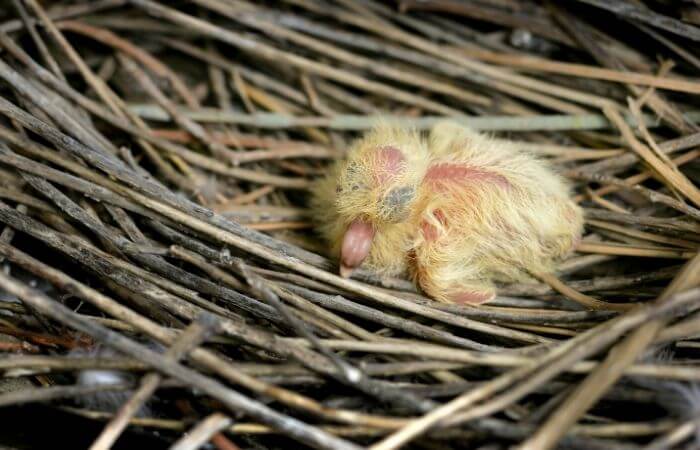
Are Baby Pigeons Real?
It is easy to dismiss this question with a simple yes, purely by referring to the circle of life.
There are no creatures on Earth, apart from one mite species, that give birth to adult, fully-grown-sized young.
Every mammal, reptile, fish and bird has babies that have to grow into adulthood, including pigeons.
Evolution has not found a way to bypass this growth phase ergo, if there are adult pigeons, there must start life as baby pigeons.
There is an idea, however, that pigeons aren’t real.
There are people who believe the conspiracy theory that pigeons are drones and only adult drones are built and that explains the invisibility of baby pigeons.
Science tells us otherwise. The life cycle of a pigeon is very well known and provides complete clarity as to why we never see baby pigeons.
What Does a Baby Pigeon Look Like?
Baby pigeons usually hatch in a nest where the parent pigeons can look after them.
They are often dark-skinned and don’t have all of their feathers yet.
Their bodies are covered in the beginnings of what will become feathers and can be yellow or white, though you might see other colors from time to time.
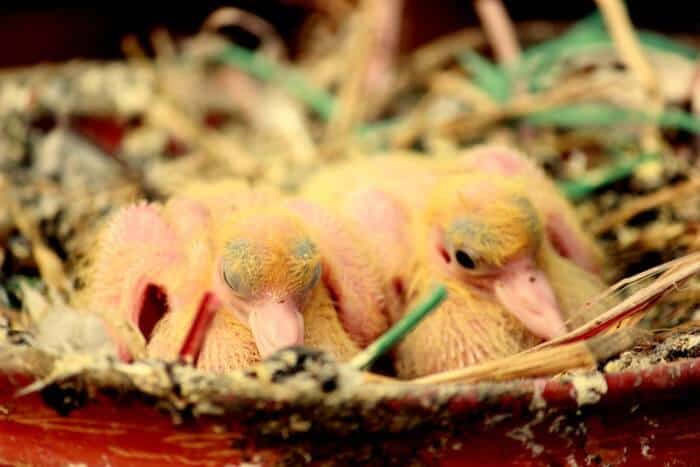
Proportionally, a baby pigeon’s wings, beak, and feet are much larger than its body and the bird will grow into them as it gets bigger.
The beak is a pinkish color but can also be a darker gray or black.
As your baby pigeon gets older, its coloring will naturally change until it resembles the adult pigeons you’re used to seeing.
By the time a baby pigeon is a few days old, it will be getting its feathers and changing colors.
Why Don’t We See Baby Pigeons?
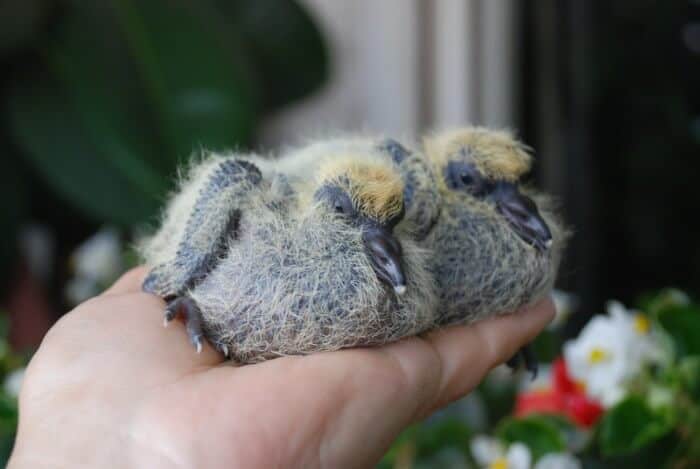
Before we address this, there’s a wider issue. Many scientists have posed the question: how often do you see the babies of other bird species?
In most communities, the only baby birds that are generally out and about are those of ducks, geese and other waterfowl. You typically won’t see baby birds of any other species.
The fact that the question of why we don’t see baby pigeons is so prevalent is probably because of the number of adult pigeons we see around us every day compared to other bird species.
So where are all the baby pigeons, especially given that there is a massive population of adult pigeons?
When pigeons are born, they hatch out of their eggs in a nest, which is generally going to be up in a tree or other hidden location.
When a mating pair of pigeons build their nest, they do so in a place that’s going to be safe and warm for their babies.
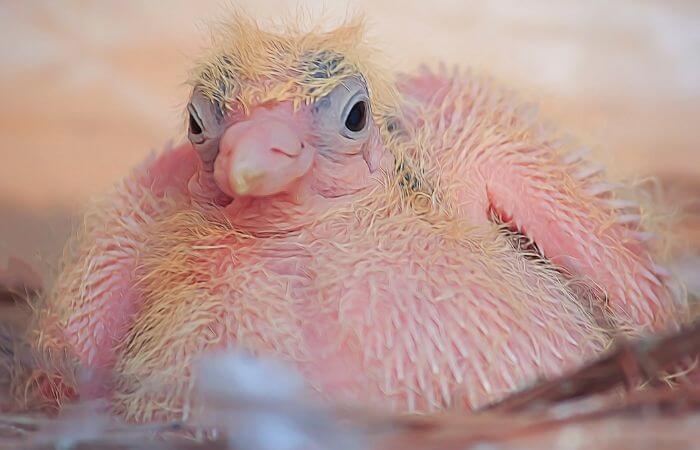
Unless you’re actively seeking out the nest, chances are that you won’t see a baby pigeon until it grows up and is ready to leave the nest.
The nesting period for a baby pigeon is roughly three weeks to four weeks – the time it takes for juvenile feathers to grow and for the bird to be able to find food and fend for itself.
For the first five days, the baby pigeon is fed purely on crop milk. After this, the parents will start to gradually introduce seeds to the baby’s diet.
At two weeks old, the baby bird should have all its feathers and the parents will no longer produce crop milk.
They will continue to feed their baby until the fledgling is ready to leave the nest which can be as early as the 25th day after hatching and as late as the 45th day.
In general, pigeons are full-grown and look like adult pigeons before they fly out of the nest.
Pigeons spend more time as nestlings than other birds so the chance of seeing one that still looks like a baby is quite small.
Just because you can’t see the babies, doesn’t mean they aren’t around.
If you listen closely or watch where the mother pigeons are going, you may be able to find out where a nest is.
Don’t approach the nest or try to touch the baby pigeons as this can scare the mother and keep her from coming back to take care of her babies.
Top Tip: If you ever find an abandoned baby pigeon and are wondering how old it is, use our pigeon age chart to work it out.
Nest Location
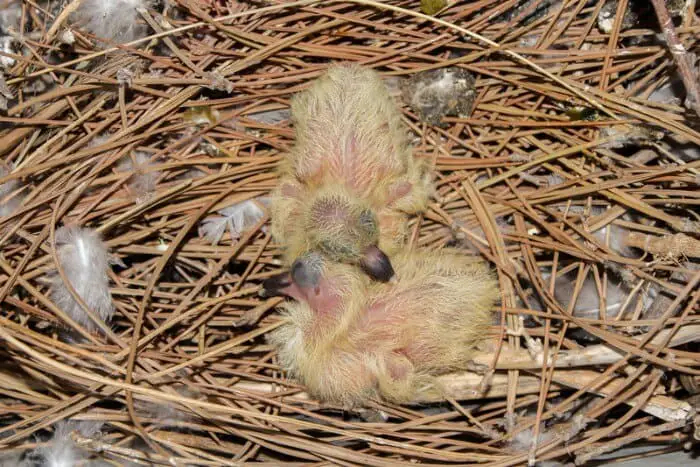
Another reason that scientists speculate we don’t see baby pigeons often is that they don’t build their nests in traditional locations.
As mentioned above, you might see the occasional one in a tree, but pigeons tend to build their nests in out-of-the-way places.
That includes on rooftops, under bridges or against the side of tall buildings.
In less urban areas, pigeons may build their nests in caves, under rocky cliffs or in other flat locations that are covered well.
These places ensure that the babies are safe from the weather and predators.
“Because of their defenseless nature, baby pigeons are an easy meal for birds of prey like falcons, owls, and sparrowhawks”, according to Animal Answer Guide.
“The eggs are also consumed by other animals that climb trees like cats, raccoons, and snakes. So adult pigeons build their nests in obscure places to protect their babies from common predators.”
In these locations, even if a baby does happen to hop out of the nest, it’s so tucked away that you wouldn’t see it anyway.
Also read:
How to Identify A Baby Pigeon
By nesting for three to five weeks, a baby pigeon isn’t as tiny and baby-like as you’d expect.
Instead, when it leaves the nest, it looks close to an adult pigeon.
However, if you know what to look for, you can identify recent fledglings.
Their feathers won’t be completely molted yet and the area around their eyes will look dark, rather than the red-orange color you’re used to seeing on an adult pigeon.
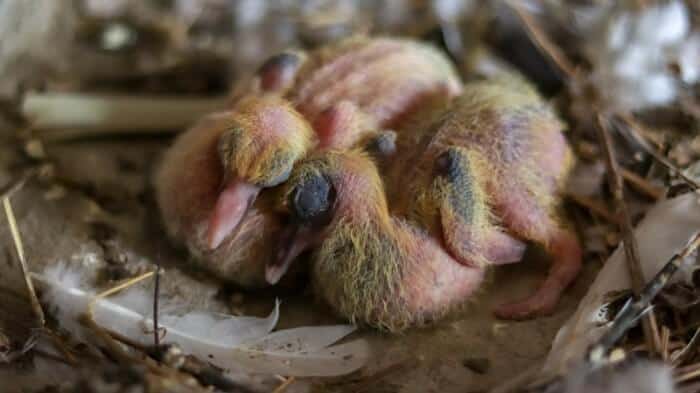
A baby pigeon won’t have the shiny green color around its neck yet and its wattle, which is above its beak, will still be a pinkish color, rather than the white you’d see on a full-grown pigeon.
As you can see, baby pigeons do exist and they’ve been studied by ornithologists for years.
Now that you know what to look for, you can identify babies in the wild and know a little bit of information that can help you get started on breeding.
